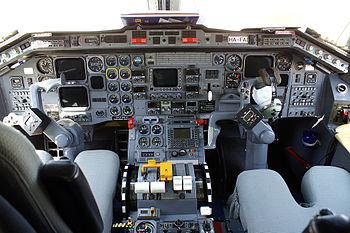Suicide burn
Sat 27 August 2022
Rocket burn (Photo credit: Wikipedia)
Principle overview
The goal of the suicide burn (also called hoverslam) [1] is to land a rocket while minimal thrust is not low enough to hover [2]. Thus, the engine must be turned off at the point where the rocket land.
The challenge is then to find when to light the engine so that the engine decelerate at the right speed to touch down at a vertical velocity of zero.
Mathematical approach
Lets begin with a modelization:
Before going to a realistic approach
Let's assume thrust is constant and is engine startup takes no time (could be a good approximation for SRB) The goal is to reach \(\frac{\partial h}{\partial t} = 0\) when \(h=0\)
Given all forces applied to the rocket, we have:
This results in a differential equation for velocity.
For the sake of simplicity, we will neglect drag forces. This means we consider the rocket is never near its terminal velocity and/or deceleration due to engine burn is way more significant than drag. That way, acceleration will be constant.
Let's put it on a graph. The point B is where the deceleration burn begins. The point G is when the velocity reaches zero (and hopefully the rocket reaches the ground).
Speed during hoverslam
The height travelled during burn is then \(h_B = \frac{v_B (t_G - t_B)}{2}`\)
The height travelled over time is
We want one and only one solution to this quadratic equation (namely G, the point where the rocket touch the ground with a null speed).
Thus the discriminant must be null:
If we constantly measure height and speed, we need to light up the engines at full thrust so that height and velocity match the aforementioned relation.
If the height is lower (resp. higher) than expected for the current speed, throttle must be increased (resp. decreased).
Real life consideration
In real life, there are small limitations.
- engine spool up time: the engine cannot go from zero to full thrust in zero second. SRB can approach this instantaneous engine ignition [3]. Thus, engine must be turned on in advance (Space X Falcon 9's engines take several seconde to relight on descent)
- instabilities and margin: given lower altitude wind and gusts and/or any unforeseen instability, margin must be taken into account. The less burn time, the less time to perform correction is available (but the more efficient is the suicide burn).
- backup solutions: given the low time available to react in case of failure, there is almost no backup solution implementable. This seems not a good solution for human-rated rockets.
Real life example
This type of landing burn has been implemented in real life. I thought is was implemented in all extraterrestrial propulsive landing (LEM, MSL, Lunokhod,...) but given the thrust to weight ratio and the throttling capabilities, those landers did not perform a suicide burn.
The only real life example I have found is the Space X falcon 9
| [1] | Scott Manley's video explaining the manouvre |
| [2] | Evryday Astronaut's video |
| [3] | Here is how it can be done |
Category: aviation Tagged: aviation Fight dynamics rocket science




